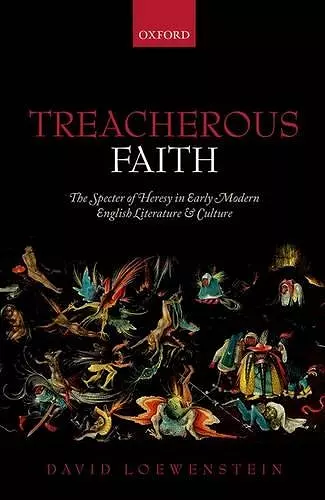Treacherous Faith
The Specter of Heresy in Early Modern English Literature and Culture
Format:Hardback
Publisher:Oxford University Press
Published:29th Aug '13
Currently unavailable, and unfortunately no date known when it will be back
This hardback is available in another edition too:
- Paperback£51.00(9780198778332)

Treacherous Faith offers a new and ambitious cross-disciplinary account of the ways writers from the early English Reformation to the Restoration generated, sustained, or questioned cultural anxieties about heresy and heretics. This book examines the dark, often brutal story of defining, constructing, and punishing heretics in early modern England, and especially the ways writers themselves contributed to or interrogated the politics of religious fear-mongering and demonizing. It illuminates the terrors and anxieties early modern writers articulated and the fantasies they constructed about pernicious heretics and pestilent heresies in response to the Reformation's shattering of Western Christendom. Treacherous Faith analyzes early modern writers who contributed to cultural fears about the contagion of heresy and engaged in the making of heretics, as well as writers who challenged the constructions of heretics and the culture of religious fear-mongering. The responses of early modern writers in English to the specter of heresy and the making of heretics were varied, complex, and contradictory, depending on their religious and political alignments. Some writers (for example, Thomas More, Richard Bancroft, and Thomas Edwards) used their rhetorical resourcefulness and inventiveness to contribute to the politics of heresy-making and the specter of cunning, diabolical heretics ravaging the Church, the state, and thousands of souls; others (for example, John Foxe) questioned within certain cultural limitations heresy-making processes and the violence and savagery that religious demonizing provoked; and some writers (for example, Anne Askew, John Milton, and William Walwyn) interrogated with great daring and inventiveness the politics of religious demonizing, heresy-making, and the cultural constructions of heretics. Treacherous Faith examines the complexities and paradoxes of the heresy-making imagination in early modern England: the dark fantasies, anxieties, terrors, and violence it was capable of generating, but also the ways the dreaded specter of heresy could stimulate the literary creativity of early modern authors engaging with it from diverse religious and political perspectives. Treacherous Faith is a major interdisciplinary study of the ways the literary imagination, religious fears, and demonizing interacted in the early modern world. This study of the early modern specter of heresy contributes to work in the humanities seeking to illuminate the changing dynamics of religious fear, the rhetoric of religious demonization, and the powerful ways the literary imagination represents and constructs religious difference.
Loewenstein is to be commended for ranging boldly across the whole period from the 1520s to the 1660s, and being impressively surefooted in the process,,, The book achieves its twin goals of illuminating the past and speaking to the present. * John Coffey, The Seventeenth Century. *
Treacherous Faith is an ambitious, scholarly and compelling survey of the fear of heresy and blasphemy across two centuries. It provides shocking evidence of the effects of that fear on the rhetoric and actions of both Cathollics and Protestants. Yet does so from a modern liberal standpoint. * Gerard Kilroy, The Times Literary Supplement *
This is a book of profound learning and powerful argument ... Above all, for its acute analysis of the construction of heresy, for its exploration of the dynamics and language of fear, and for its fresh contextualization and interpretation of Milton's writings, this book will be essential reading for literary scholars and historians of early modern England. * David L. Smith, Milton Quarterly *
The timeliness of Treacherous Faith as both a study of heresy and of extreme religious understandings makes this study one which should become required reading for a range of scholars and students across a number of disciplines. Indeed, Loewenstein's work provides an exemplum to anyone who poses questions over the significance of early modern study to the modern world. * Christopher Stone, Journal of the Northern Renaissance *
This is a detailed and careful assessement combining insights from studies of history, literature and culture to offer an interdisciplinary appreciation of the ways that the fear of supposed heretics could be used to shape public and political attitudes. * Stephen Copson, Baptist Quarterly *
ISBN: 9780199203390
Dimensions: 236mm x 162mm x 34mm
Weight: 904g
512 pages